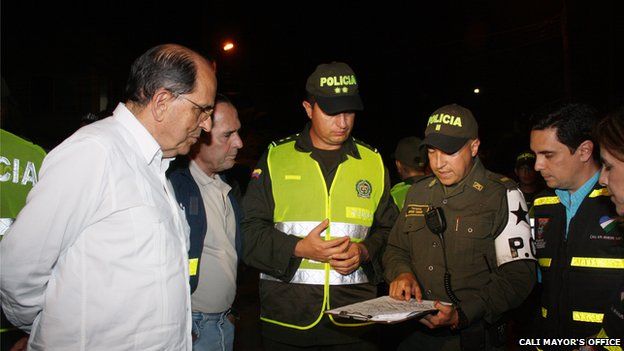Colombia mayor fights Cali's murder rate with science
- Published

One of Colombia's most violent cities is successfully using science to combat crime.
But it is not the kind of science you see in TV dramas such as CSI: Crime Scene Investigation.
Dr Rodrigo Guerrero is the mayor of Cali, Colombia's third largest city, and a Harvard-trained epidemiologist.
By applying the tools of his trade he has, during his second time in office, once again managed to cut down the city's staggering murder rate.
"I estimate that, by the end of the year, it will be 58 or 59 per 100,000 inhabitants," says Dr Guerrero, who first served as Cali's mayor from 1992 until 1994 and returned to office less than two years ago.
"It still is a terrifying rate, but last year's was 81. And we're confident things will get better," he tells the BBC.
Forensic work and the latest technology - CSI style - have certainly a role to play in what Dr Guerrero is trying to achieve.
But he says he is mainly "using the method we epidemiologists use when we face unknown diseases", as he also did 20 years ago.
"We always assume there are multiple causes," explains the mayor.
"The secret, then, is to identify the different risk factors in order to deal with them. And to keep evaluating the results."
Analytical tools
It sounds like common sense. But before the mayor of Cali started doing so in 1992, nobody here had thought about approaching urban violence as an epidemic.
Back then the city's murder rate was a massive 126 per 100,000 inhabitants. And it was widely assumed than most deaths were linked to drug cartels.
A careful analysis of all murder cases, however, allowed for the identification of other risk factors: alcohol and guns.
So Dr Guerrero decided to tackle those two problems head on.
"There's a study, published in the American Journal of Epidemiology, that shows that during the periods in which we imposed restrictions on gun carrying and alcohol sales murder rates dropped by 35%," says Dr Guerrero.
"Bogota then replicated the experience, with the same results," he recalls.
After leaving office, the epidemiologist went to work with the Pan-American Health Organisation and the Inter-American Development Bank, which helped him to replicate the model in some 18 countries throughout the region.
New diagnosis
But, during that time, Dr Guerrero's home city stopped applying the method "judiciously", he claims.
That meant that, once he got back in office, in January 2012, he had to start working on a new diagnosis.
"What we've found this time is that a large proportion of murders are linked with organised crime: there was premeditation, the killings usually involved automatic guns, etc," he explains.
"So we got in touch with the central government and convinced them we needed to apply the same strategy used to dismantle the drug cartels 20 years ago."
This involved setting up specialised taskforces, involving both the police and the judiciary, in order to fully dismantle the criminal groups.
'Room for improvement'
And after two years of work the first results are starting to show.
"Of course, not all the violence is crime related," acknowledges the mayor, who says the fight against inequality is fundamental to solve the problem in the long term.
"But there's a lot that can be done in the meantime," says the epidemiologist, who estimates the work being done in Cali has already saved more than 400 lives in the past 12 months.
The approach championed by Dr Guerrero also earned him the first ever Roux Prize, awarded last week by the University of Washington's Institute for Health Metrics and Evaluation.
But he has some more important victories in mind.
"When I got re-elected mayor of Cali I promised to cut down the murder rate to 60 per 100,000. But that's already done, so my new goal is to bring it down to 45 or 40," he says.
"There's room for improvement. And if we continue working hard we'll get results. No doubt about that."